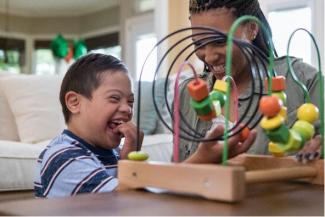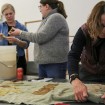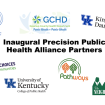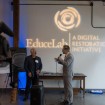Intergenerational Initiative Will Offer Toys with a Purpose in Hazard

The University of Kentucky Center of Excellence in Rural Health (UK CERH) in Hazard, Kentucky, in partnership with the Kentucky Appalachian Rural Rehabilitation Network (KARRN), will be the home site of Toys with a Purpose, a new intergenerational initiative that will establish a lending library to support child development and promote learning through play by improving access to free adapted toys in Eastern Kentucky.
Toys with a Purpose will expand the capacity of the well-established and highly successful Project CARAT (Coordinating and Assisting the Reuse of Assistive Technology) by utilizing grant funding from the Commonwealth Council on Developmental Disability that was awarded to KARRN.
“Play is part of normal child development and is essential for developing creativity, imagination, dexterity and physical, cognitive and emotional strength,” said Patrick Kitzman, professor of physical therapy with UK College of Health Sciences. “In addition, play helps with language, math and social skills and even helps children cope with stress. Toys are integral to play, yet children with disabilities are often unable to use off-the-shelf toys and purchasing manufacturer-adapted toys can be very expensive.”
Toys with a Purpose will also involve two other linked programs — a collaboration with local high schools in Perry County and intergenerational mentoring. Senior citizens and veterans of all abilities will pair with students of all abilities for mentoring, community engagement and development of strategies to grow the lending library.
“We are very excited about this opportunity for members of our local community from different generations to bring together their unique skill sets, knowledge and talents,” said Fran Feltner, Ph.D., director of the UK CERH. “They will not only gain experience in collecting and refurbishing existing toys, they will also have the opportunity to develop adapted toy prototypes and educational materials using the principles of Universal Design in Learning.”
Organizers of Toys with a Purpose expect the mentoring part of the project to begin this fall, and toys to be available in 2022. For more information, contact coordinator Keisha Hudson at keisha.hudson@uky.edu or 606-439-3557.
Kentucky Appalachian Rural Rehabilitation Network (KARRN) is a collaborative team that advocates to empower communities impacted by disability. Established in 2008, this community-engaged network has investigated and developed strategies to reduce disability and improve quality of life for individuals with neurological impairments (spinal cord injury (SCI), brain injury (BI), stroke, etc.) living in underserved and impoverished rural Appalachian counties. Under the umbrella of KARRN is the physical therapy student-ran Project CARAT (Coordinating and Assisting the Reuse of Assistive Technology).
Project CARAT is a community outreach, service learning program that aims to make assistive technology and durable medical equipment (DME) more accessible in underserved areas of Kentucky. The UK Center of Excellence in Rural Health and Carl D. Perkins Center were the original sites for Project CARAT. The UK CERH site is unique in that it provides a service learning program run by UK Doctorate of Physical Therapy students. Students are trained to clean and refurbish DME to distribute to those in need. Project CARAT has several locations across Kentucky and is part of the Kentucky Assistive Technology Service Network (KATS).
The UK Center of Excellence in Rural Health (UK CERH) was established by state legislation in 1990 to address health disparities in rural Kentucky and the unique challenges faced by our communities. The mission was and still is today to improve the health and well-being of rural Kentuckians. For more than three decades, the center has partnered with communities, providers, students and individuals to provide health professions education, health policy research, health care service and community engagement toward reaching this mission.


